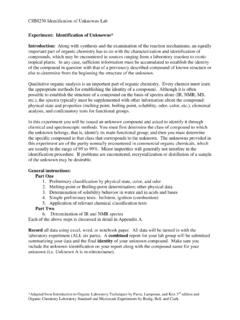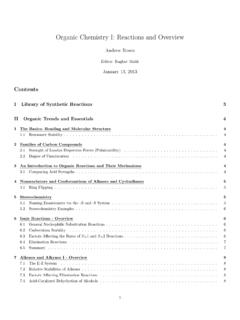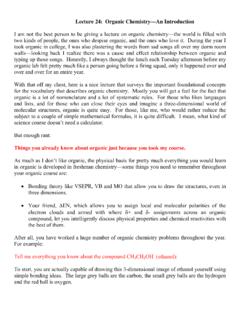Transcription of An Introduction to Functional Groups in Organic Chemistry
1 An Introduction to Functional Groups in Organic Molecules Portions of this experiment were adapted from Lehman, J. W., Operational Organic Chemistry , Upper Saddle River, New Jersey: Prentice-Hall, 1999. Introduction Qualitative Organic analysis, the identification of Organic compounds based on their physical and chemical properties, is analogous in some ways to the identification of plants and animals according to their taxonomy their structural features and presumed natural relationships. To classify an Organic compound into a given family requires first detecting a specific Functional group (characteristic set of atoms) in the molecules of Organic compounds. Because Functional Groups influence the physical, chemical, and spectral properties of an Organic compound, a chemist can identify a compound's Functional Groups by measuring certain physical properties, observing its chemical behavior with different classification reagents, and studying other spectral data.
2 In this experiment we will subject a series of Organic compounds to specific chemical reactions in order to identify which class of Functional group the substance belongs to. Some common Organic Functional Groups Functional group name General formula* Alkene RCCR' Alkyl halide RClRBror Alcohol ROH Aldehyde RCOH (R CHO) Amide RCONHR' Amine RNHHRNR'HRNR'R'' Carboxylic acid RCOOH Ester RCOOR' Ether ROR' Ketone RCOR' *R, R', and R'' are general hydrocarbon Groups Functional group identification tests Chemists have developed a number of simple chemical tests that are positive only for compounds having certain kinds of Functional Groups . These are the four tests we will be performing today: Compounds that are easily oxidized react with a solution of chromium(VI) oxide in sulfuric acid, commonly referred to as "chromic acid." Primary and secondary alcohols react within 2-3 seconds to form an opaque blue-green suspension. Aldehydes give the same result but usually take 10 seconds or more to react.
3 Aldehydes and ketones both react with 2,4-dinitrophenylhydrazine (DNPH) reagent to yield yellow or orange precipitates within a few minutes. Alkenes react readily with dilute aqueous potassium permanganate to form a brown precipitate as the purple color of the permanganate disappears. Alkyl halides give a green flame in the Beilstein test, which involves heating a copper wire moistened with the unknown in a burner flame. Procedure 1. First, you will be performing the Functional group identification tests on known compounds (indicated in each of the test procedures) for which each of the tests should produce a positive result. Note your observations carefully in your laboratory notebook after performing each of these tests, as they will be helpful in identifying an unknown compound later. 2. Steps 3-6 can be performed in any order. One of the following tests will be set up in one of four fume hoods in the lab. When you are finished with a test, move to another hood to perform another test.
4 3. 2,4-Dinitrophenylhydrazine (2,4-DNPH) test: Add 1 drop of the compound to be tested (in this case, reagent-grade acetone will give a positive test) to 500 L of the DNPH reagent in a small disposable test tube. (The disposable test tubes hold roughly 1000 L of liquid, so simply estimate the volume) Stopper the tube with a small rubber septum (the instructor has these) and shake the test tube and let the mixture stand for 15 minutes. Carefully record your observations. The septa are expensive and are not disposable so please rinse them and return them to your instructor when finished. 4. Chromic acid test: Dissolve one drop of the compound to be tested (in this case, ethanol will give a positive test) in ~500 L of reagent-grade acetone in a small test tube. Add 1 drop of the chromic acid reagent, shake the mixture, and observe it for at least one minute, noting the time required for any positive test. Carefully record your observations.
5 5. Potassium permanganate test: Dissolve 1 drop of the compound to be tested (in this case, limonene will give a positive test) in ~500 L of 95% ethanol, and slowly add 5-10 drops of M potassium permanganate with shaking. Note what happens after each drop is added. 6. Beilstein's test: Make a small loop in the end of a 10-cm length of copper wire. Heat the loop to redness in a burner flame. (Keep the unknown and any other flammable liquids at a safe distance.) Dip the loop into a little bit of your compound to be tested (in this case, bromobenzene will give a positive test) and hold it in the lower outside part of the flame. Note the color of the flame produced. 7. Obtain a numbered unknown from your instructor and record its number in your laboratory notebook. Important: cap your unknown vial tightly after removing the required amount for the tests, as these compounds may have strong smells and will evaporate very quickly!
6 Perform each of the four Functional group classification tests as in steps 3-6, but use your unknown as the test compound as opposed to the control compounds in the instructions above. Carefully observe and record the results of your tests, and decide whether they are positive or negative. (Positive tests should look similar to the tests with the control reagents in steps 3-6). Note: some tests may sometimes provide ambiguous results. The purity of the test reagent and the unknown compound can have adverse effects on these tests, so it is especially important to prevent cross-contamination today. The 2,4-DNPH reagent has been known to crystallize a small amount on its own, so you should look for heavy crystallization as a sign of a positive test. Consult with the instructor and/or run a test again if the result seems ambiguous. 8. Using the Organic modeling kits, make models of each of each of the four standard chemicals used in the positive tests (acetone, ethanol, limonene, and bromobenzene), as well as 1-bromobutane, 2-butanone, cyclohexene, 1-butanol.
7 (a web search will help you identify the structures of acetone and limonene). Show these models to your instructor. 9. Use your reasoning skills to deduce which Functional group (s) may be present in your unknown compound. Based on the Functional group tests, identify your unknown compound by choosing it from the following possible unknowns: 1-bromobutane, 2-butanone, cyclohexene, 1-butanol. Waste disposal After each of your chemical tests is complete, dispose of the chemicals and the disposable test tube in the waste container in the hood where the test was conducted. Dispose of any of your unused unknown chemical after you are sure of its identity in the waste container and place the empty vial in the collection bin provided. Do not mix up the used unknown vials with the new ones!Report You may choose to submit an individual or group report for this lab. If you worked in pairs and are submitting this assignment on an individual basis, please underline your own name and include your lab partner s name on the assignment.
8 Follow the guidelines for Laboratory Reports at Please read these guidelines very carefully before beginning the report, especially if you did not take Chemistry 1061 lab last semester. In your report, please include a title, procedure, results, and discussion. When completing the results section, the following information should be included: 1. Using ChemSketch, draw the correct chemical structures as line-angle formulas for each of the standard and possible unknown chemicals in this experiment (acetone, ethanol, limonene, bromobenzene, 1-bromobutane, 2-butanone, cyclohexene, and 1-butanol). Include these in a Microsoft Word file, along with the names of the chemicals. Also include the correct IUPAC names for acetone and limonene. 2. Make an organized table that neatly shows the results of your four positive standard tests. Indicate the following in the table for each of the four tests: the name of the test, the name of the standard compound which was tested, a brief summation of the observations recorded, and the name of the Functional group which was tested for.
9 3. Make an organized table that neatly shows the results of the Functional group tests on your unknown compound. Indicate the following in the table for each of the four tests: name of the test, observations, conclusion as to which Functional Groups are present or not based on that test. In the discussion, please make sure to include the identity of your unknown and how you were able to make this determination. Follow your instructor s directions for submitting this lab report. Remember to name the file as specified near the beginning of Assignment section (Lastname Lab 3 or Lastname1 LastName2 Lab3). If you are emailing your report, use the subject line Chem 1062: Functional Groups Lab . If you worked in pairs and are submitting this assignment on an individual basis, please underline your own name and include your lab partner s name on the assignment.









